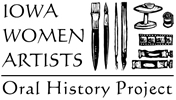PEGGY JESTER
artwork | audio | statement | 2008 update
artwork
audio 
- Children & painting (40 sec. | 277KB): listen | read
- Art play (37 sec. | 255KB): listen | read
- Active visual sense (36 sec. | 252KB): listen | read
- Neighborhood issues (50 sec. | 340KB): listen | read
- Personal learning evolution (42 sec. | 289KB): listen | read
artist statement
I increasingly feel the need to create paintings and prints that originate from a deeper place within me. I no longer have the need to try all mediums, techniques. This "place" seems difficult to find, hang onto. There is no magic, no instruction manual, no new experience needed to get there. I look into myself and the future for a clearer focus somewhat fearfully but with hope and joy.
2008 update
In 2004, I purchased an etching press. At that time I was on the faculty at the Des Moines Art Center teaching printmaking and drawing and I often worked there on prints off times. I wanted to have my own press in my studio.
In 2005, I began using Z*Acrylic polyester plates with lithographic properties. The images I used are from a found 1930's album of 3"x3" black and white photographs which I enlarged on a laser printer and printed onto the polyester plate. I enjoyed layering the images using many colors, images and transparent overlays.
In 2006, I began another experimental project: plants and flowers layered onto Plexiglas plates, then laid on damp printing paper that often already was printed with one or more transparent colors. The results amazed me...embossed relief forms often oozing with colors from the plant material. I have shown both series in exhibitions and art fairs. They have been well received.
The summer of 2007, I spent a week at Crown Point Press in San Francisco under Kathan Brown doing an intaglio workshop, learned more about classic intaglio techniques.
Spring 2008: Thinking a lot about painting. What does one paint?
audio text
Children & painting
We had our first child in '63...third child in 1970. I did not do any artwork during those years. I got into antiques, refinishing furniture, decorating. After we moved to our house on Cottage Grove in 1975, our children were in school. I wanted to go back and learn to paint. I'd always wanted to use color. I had tried some painting on my own before that, and I just didn't know what I was trying to do. Actually, I recognize now that I didn't have anything to say in my paintings.
Art play
When I was in school, I didn't really think I could play. I had to have a certain body of work ready at a certain time. I guess it had to look skilled, and to me looking skilled meant making it as realistic as you could. The more I play, the more I find areas and insights and color relationships that are new to me and interesting in ways I want to repeat. The whole painting may not work, but there's one or two areas where something new comes out, an evolution takes place. So I kind of want to play a little bit more. And that's what I'm doing.
Active visual sense
I just look at the world when I'm doing art work; I have a really active visual sense for detail, especially. First of all, I look at it—whether it's a seed or a flower or whatever, a bird—as a unit of nature. But next, an aesthetic judgment about the way the forms fit together, and how they relate to the shapes behind it, or how the color interacts—or what red is that? And what green is that? And how does it work? It's really an interesting process to think about, to be involved with mentally.
Neighborhood issues
I have done a lot of advocacy and volunteer work with neighborhood issues. Worked most recently with a city commission that devised a preservation plan for the City of Des Moines. Somehow that kind of work balanced the artwork that is so insular and quiet and alone. And I used the outlet with neighborhood issues and those kinds of issues to be with other people, and be involved with other issues.
The paintings that I really feel mean the most to me are the little neighborhood paintings where—nothing concrete of human existence, no people, but—either through the light or the shapes, there is a sense of habitation and a sense of someone caring.
Personal learning evolution
Personally for me, art has been a great learning experience. I've learned so much about being patient, having confidence in my own thought processes, learning to keep at it. I used to re-work and re-work and re-work the same painting. And I've learned now, just start another one, and keep at it. Just keep working, and it'll—a lot of the time—work itself out. It may not be the same painting that you had in your head, but—get over it! Just go have confidence in yourself. It's taken me so long to learn those lessons. It's just been a real personal learning evolution for me.





